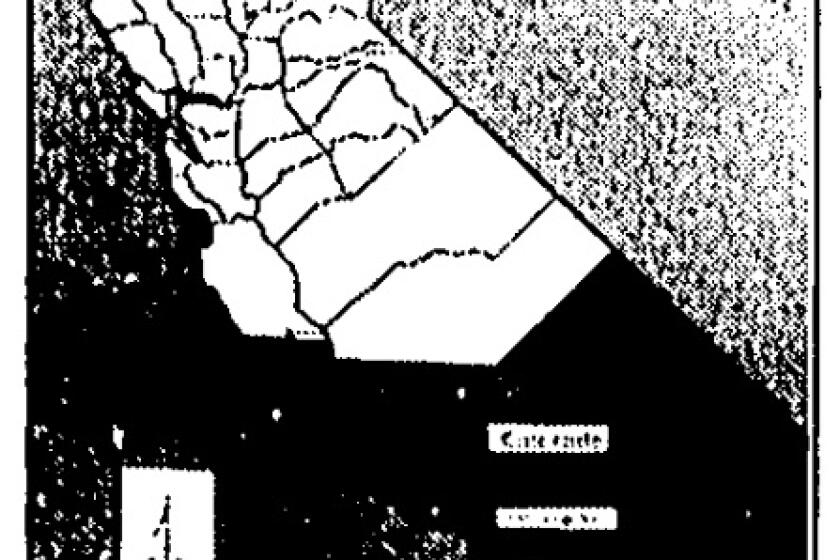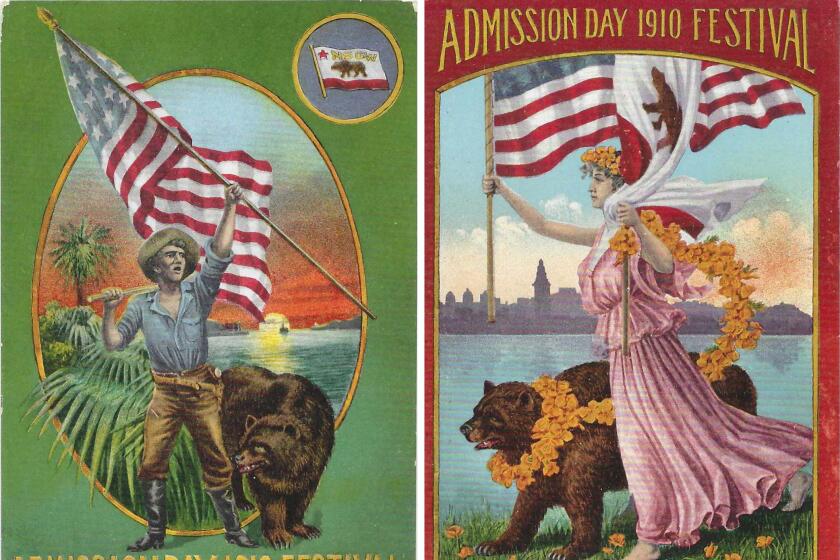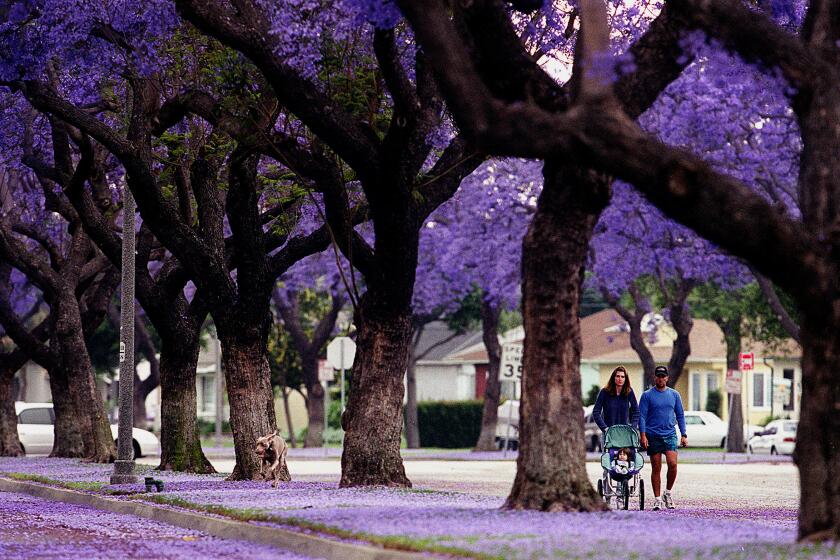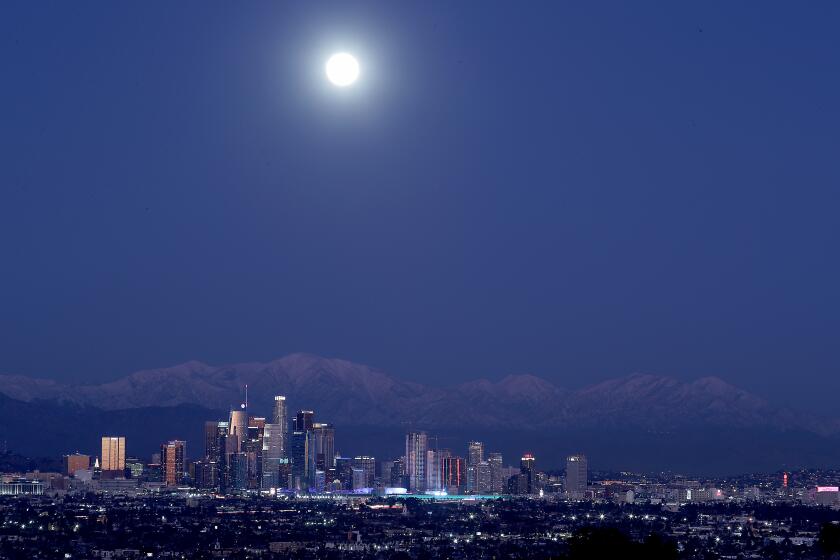Why has massive California never been split into two states? Or six?
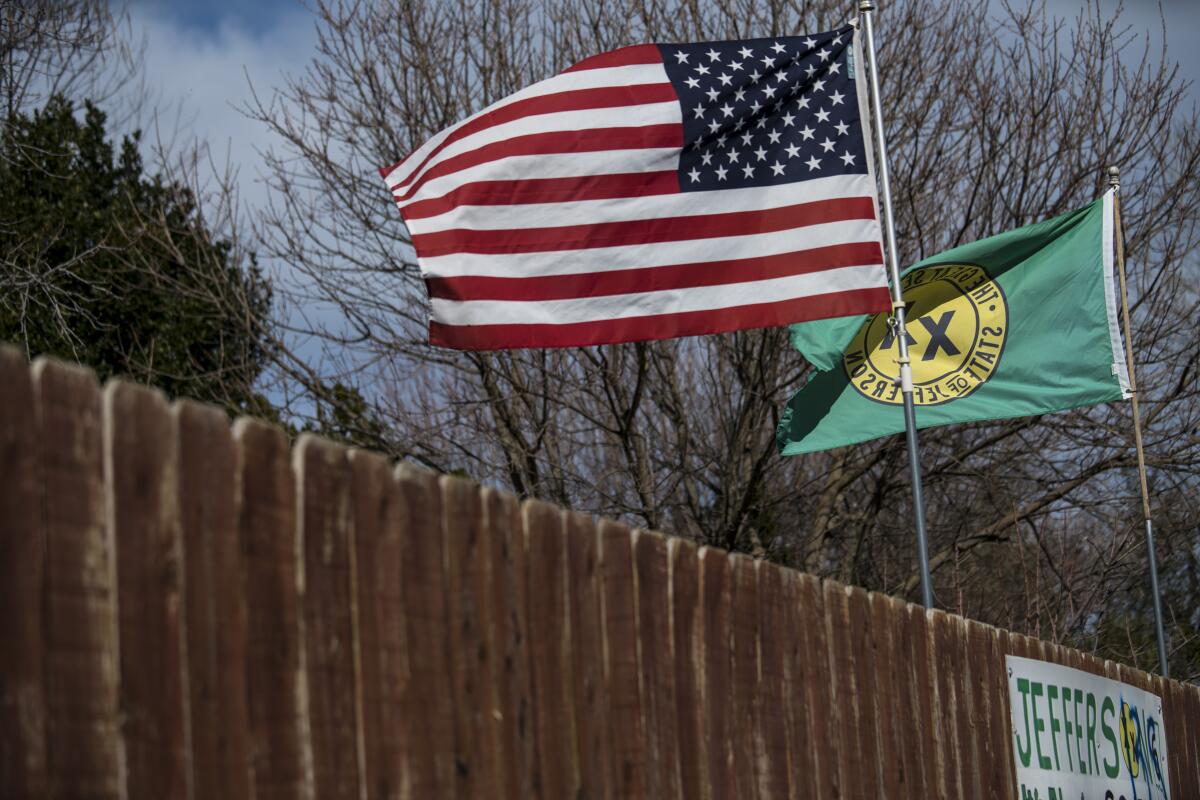
- Share via
Thought you’d be in the clear for a while, didn’t you?
With the recall election over and done with, and no other pointlessly expensive ballot measure immediately in the offing, you figured you could tune out election chatter? Forget it, Jake; it’s California politics.
Like awaiting an earthquake, we are due — overdue, really — for another aggrieved someone to try once again to get voters or legislators or Congress — or all three — to agree to divvy up California into two or three or a half-dozen states.
Why would I think that? I leave the arithmetic to you: About 220 times in more than 170 years, some interest or power or politician waved around a cleaver and cried, “Hey, let’s chop up California!”
The last time this happened was three years ago, which is forever in politics.
Explaining L.A. With Patt Morrison
Los Angeles is a complex place. In this weekly feature, Patt Morrison is explaining how it works, its history and its culture.
In July 2018, one day before the November state election ballot was being sent to the printers, the California Supreme Court unanimously yanked the Three States Initiative off the ballot because of “significant questions” about its validity and “the potential harm” of leaving it on the ballot.
The three-state divvy got that far because, over the course of four years, venture capitalist Tim Draper had emptied his own wallet of something above $5 million to persuade Californians to vote to subdivide California: initially, into six states, then, by 2018, a pared-down three.
“WTF?” was Draper’s Facebook riposte to the court’s warning. “Apparently, the insiders are in cahoots.”
None of these votes and bills has the force of law; California can’t unilaterally divorce itself. The U.S. Constitution decrees that “no new State shall be formed or erected within the Jurisdiction of any other State; nor any State be formed by the Junction of two or more States, or Parts of States, without the Consent of the Legislatures of the States concerned as well as of the Congress.”
But all of these tries can at least roil state governance, and can even set in motion requirements like a “yes” vote of the people of California and an official request to Congress to approve the big breakup.
Mostly, these state-sundering tantrums have been delish meat for national publications to chow down on cherished clichés about the California dream dying, dying, dead.
This article by Charles Hillinger ran in the Los Angeles Times Aug. 25, 1986. Headline: “Two Californias? A Split Decision.” Subheadline: “More Than 100 Attempts Have Been Made to Divide State.”
Yet why would Californians want to divorce themselves? Cut up a nation-state that is “the glory, jest and riddle of the world,” to steal a blurb from Pope the poet?
California is two-thirds the size of France, with a bigger economy, yet the answer is usually “ungovernable.”
Even before statehood, in 1850, first Spain and then Mexico tried to govern their terra incognita from thousands of miles away. And men had agitated to chop up that California into digestible pieces. Nowadays, when oxcart and sailing ship no longer govern governing, Sacramento is still at least symbolically remote from Californians, even though they send their own legislators there.
So the reasons have shifted along with California’s faces and fortunes.
Three years after California became a state, an assemblyman named Jefferson Hunt broke up Los Angeles County — which once reached all the way to the Colorado River — and created San Bernardino County.
Then he tried to do the same with the state. Hunt got his fellow assemblymen to vote for it — they even liked the idea of making three states, named Shasta, Colorado and California.
But the state Senate balked, probably picking up on rumors that the muscular pro-slavery forces in Southern California wanted any new states to be slave states.
For an officially free state, California harbored a lot of Southern sentiments, and in the 11 tense years between statehood and the Civil War, California was a kind of surrogate battlefield of secession.
Southern California had more cattle than voters back then and was, lamentably, a snug cradle for Confederate feeling. More than a few civic leaders and military men were pro-Dixie, like L.A.’s Civil War-era mayor Damien Marchesseault, who wanted southern California to follow the Confederacy into secession.
And Milton Latham — who was governor for only five days in January 1860 before he finagled his own appointment as a U.S. senator — used those five days to lean on President James Buchanan to wield the big state-splitting knife, because “the union of southern and northern California is unnatural.”
Sept. 9 marks the day in 1850 that California became a state. It used be a major holiday in California, with parades and festivals. Nothing is stopping you from celebrating, of course.
The closest we got to an actual breakup came, paradoxically, from the brother of the last Mexican governor of California. Andres Pico was an assemblyman in the new state of California. In 1859, his act to bisect California horizontally, around San Luis Obispo, got the blessing of the legislature, the governor and 3 out of 4 voters, and was sent to Congress — where it ran into a little impediment called the Civil War.
In starched-collar language, Pico’s act made the same point that splitter-uppers make to this day: “Whereas, the present boundaries of the State of California enclose an area of such extent and so diversified in physical and other features as to preclude, to an unwholesome degree, the possibility of uniform legislation, and render cumbersome and expensive the operation of government.“
As late as 2019, a letter writer to the Chico Enterprise-Record feelingly insisted that the Pico Act has never timed out and that Congress could still make it happen.
After the Civil War, the breakup movement kept going by fits and starts, over who was getting the rawest deal on you-name-it. Taxes were unfair, by geography, by population, by industry. We pay more than you do. Do not. Do so.
Cow counties were aggrieved about mining counties, and vice versa. Thirsty counties versus water-blessed counties. Agricultural counties versus citified ones, densely populated versus sparsely populated, poor counties feeling steamrolled by the interests of rich ones — people in every generation had a new reason to cut up California. When times were hard, the agitation accelerated; local control, the split-state supporters argued, would keep our money close to home. What money? the opponents shot back.
The federal argument sounded more persuasive: Two or three Californias, with two or three times more U.S. senators, would give the myriad millions of Californians the national voice they deserve. (And what guarantee was there that a state with such internally divided interests would come together to vote with one voice nationally?)
It’s paradoxical that the split movements are often generated by Republicans, the party that abhors the idea of more politicians, more government, more government costs. As the conservative L.A. Times editorialized in 1965, when the matter came up again, how would many new Californias shoulder the whole state’s earlier bond commitments? Every profession would need a new licensing board and practices, and every profession wanting to do business in another California would have to repeat the process there.
“The potential for economic chaos resulting from such a whimsical creation” could be instrumental in destroying “the greatest U.S. economic unit,” The Times wrote.
The earliest state-splitting Solomons drew the dotted line at Big Sur, then moved it farther south, along with the L.A. population: San Luis Obispo, then the Tehachapi Mountains.
Almost no Bay Area public figure could let go of the classic north versus south, L.A. versus “don’t call me Frisco” sore-headed feud. San Francisco took an early lead in California with the Gold Rush and all, and the postcard-sales metric between the Golden Gate Bridge and the Hollywood sign is unflagging.
The 1906 San Francisco earthquake tipped the state’s fortunes and population toward the south, and the north has never gotten over it. (Democratic political power remains in the Bay Area’s grasp.) The little book “The War Between the State” by Jon Winokur is a testament to that dispute, a collection of snarky aphorisms aimed across the Tehachapis from people like Mark Twain (and me).
A year after the 1906 quake, the San Francisco Call newspaper scolded Southern California for seeming “to be infatuated with the notion that its prosperity would be promoted by separation — though it has no interests which are not identical with those of northern and central counties, and it is impossible to conceive any measure on which the state might logically divide on sectional lines. … We are all as one man opposed to any diminution of the area of the State … to become, in the fullness of time, with the natural growth which it may fairly expect, one of the great commonwealths of the civilized world.”
But interests and identities shift. Coastal California is politically and culturally a place now more homogeneously inclined from redder, inland California.
Water projects and regional booms have evened out some of the earlier north/south imbalances. And as early as 1970, a Yreka senator suggested a lengthwise state split, a kind of hippie-versus-harvest. Almost 40 years later, a termed-out Republican assemblyman from Visalia started a nonprofit called Citizens for Saving California Farming Industries, to slice up the state between 13 coastal counties; the remaining 45 counties would be, harrumph, “the real California.”
Like mice or ants, the idea kept getting squished but always found a way back in, mostly from politicians who could campaign on telling the folks back home that they had done their best. A midcentury state senator tried four times to get his colleagues to approve it.
You can determine L.A.’s seasons by our plant life. For example, right now, it’s jacaranda-blooms-stuck-to-your-windshield season. And to understand the Southern California landscape you see, you have to realize that, like you, it is probably not from around here.
State-splitting got its most emphatic modern boost in 1992. A Republican legislator from Chico named Stan Statham — known to political history as “Three-State Stan” — wanted to get a breakup vote on the November 1994 ballot.
Invoking the name of the president of the Confederacy, a Democratic lawmaker called Statham “the Jefferson Davis of California.” The Assembly passed Statham’s bill, but the Senate rules committee deep-sixed it.
This was going on when I was a founding co-host of a public affairs program on KCET-TV. We ran a contest asking viewers to name the three prospective new states. There was a winner, which I remember was — north to south — “Logland, Fogland and Smogland.” And then there was my personal favorite, which was — south to north — “Id, Ego and Superego.”
Naming some prospective new morsel of California is the easy, fun part. Shasta, Columbia, Colorado had their day, and Draper tapped a deep and displeased nerve when he suggested that one of his six new Californias be called “Jefferson.”
“Them: Covenant” on Amazon Prime is a reminder of the all-too-common housing covenants that restricted who could buy homes in certain neighborhoods in Compton, around Southern California and elsewhere. Determined Black people over the decades fought for their rights to live where they pleased.
The Jefferson statehood movement — at least eight decades along now — bubbles up in far-northern California and southern Oregon with the shared rural and forestry interests and resentment of bigfooted, big-city-driven politics. In 1956, people in six northern California counties declared their intention to secede and create the state of Shasta, which would allow gambling and end income and sales tax, a kind of forested Nevada. Nada, of course, came to pass.
It’s also a chimerical Pacific Brigadoon. Voters and local elected bodies have said time and again they wish to be Jeffersonians rather than Californians or Oregonians. (The name “Jefferson,” for the president who thought of great cities as “pestilential to the morals,” won a newspaper contest over other entries whose numbers included Bonanza, Discontent and Orofino.)
It made itself vigorously known in the autumn of 1941, when, for a while, every Thursday, the region “seceded,” and men with rifles made traffic stops at the “state line.” “Jefferson” elected a governor on Dec. 4 and celebrated with an inaugural parade in Yreka, led by a bear named Itchy. Three days later, Pearl Harbor stopped the movement cold.
Still, the Jefferson dream lives on, in the form of flags — a gold pan and two Xs, a heavy-handed symbol of the double cross — that, during the pandemic, have adorned face masks. A southern Oregon public radio station named itself Jefferson Public Radio, and “State of Jefferson highway” signs appear on roads.
Wherever the line is drawn, a state-split measure will be coming, sooner or later, to a ballot near you.
And you thought the recall, initiative and referendum were mischief enough.
L.A. is a place like no other. You’ve got questions. Patt Morrison probably has answers and can definitely find out.
More to Read
Sign up for Essential California
The most important California stories and recommendations in your inbox every morning.
You may occasionally receive promotional content from the Los Angeles Times.

